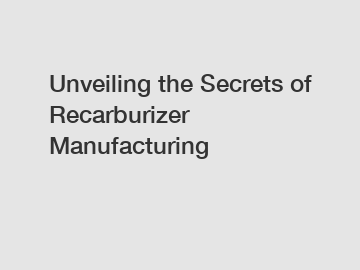Unveiling the Secrets of Recarburizer Manufacturing
Unveiling the Secrets of Recarburizer Manufacturing.
In modern industrial processes, the importance of recarburizer cannot be overstated. Recarburizers are essential additives used in the production of steel and iron alloys, providing carbon content to enhance the quality and performance of these materials. However, the manufacturing of recarburizers is a complex and detailed process that requires specialized knowledge and expertise. In this article, we will delve into the secrets of recarburizer manufacturing, shedding light on the various stages involved and the key factors that contribute to the production of high-quality recarburizers.
1. Understanding the Raw Materials.

One of the primary secrets of successful recarburizer manufacturing lies in selecting the right raw materials. The quality and composition of the carbonaceous materials used directly impact the final product. Generally, petroleum coke, coal tar pitch, and calcined anthracite coal are the commonly used carbonaceous materials due to their high carbon content and low impurity levels. Careful analysis and sourcing of these raw materials are crucial to ensure the creation of recarburizers with optimal carbon content and desired chemical properties.
2. Mixing and Blending.
Once the appropriate raw materials are acquired, the next step involves mixing and blending them in precise proportions. This process allows for the creation of a uniform mixture that assures consistency in carbon content and performance. The use of advanced blending technologies and equipment is crucial to achieve the required homogeneity and minimize variations in the final product.
3. Carbonization and Graphitization.
After the blending process, the mixture undergoes carbonization and graphitization. Carbonization involves heating the blend at high temperatures, which drives out volatile matter and converts the carbonaceous materials into fixed carbon. The carbonized product is then further treated through graphitization, which involves the application of intense heat to enhance its graphitic structure, resulting in improved electrical conductivity and stability.
4. Crushing and Sizing.
The carbonized and graphitized product is then crushed into smaller particles to achieve the desired sizing. Proper sizing is essential as it affects the rate of dissolution and dispersion in the molten metal during steelmaking or iron casting processes. Precise control of particle size distribution is critical to ensure optimal performance and minimize wastage.
5. Quality Control and Testing.
Throughout the manufacturing process, strict quality control measures must be implemented to guarantee the production of high-quality recarburizers. This includes comprehensive testing at various stages, such as analyzing the composition, carbon content, moisture levels, and ash content. By conducting thorough quality control checks, manufacturers can ensure that the recarburizers meet the required specifications and deliver consistent results.
In conclusion, the secrets of recarburizer manufacturing lie in understanding the raw materials, precise mixing and blending, carbonization and graphitization, crushing and sizing, as well as rigorous quality control. These factors collectively contribute to the production of high-quality recarburizers, which play a vital role in optimizing steel and iron alloy production processes.
If you are in need of high-quality recarburizers for your industrial operations, contact us today. Our team of experts can provide you with the best solutions tailored to your specific requirements.
If you want to learn more, please visit our website Metallurgical coke carburizing agent, graphite electrode uses, Metallurgical coke carburizing agent.

Comments
0